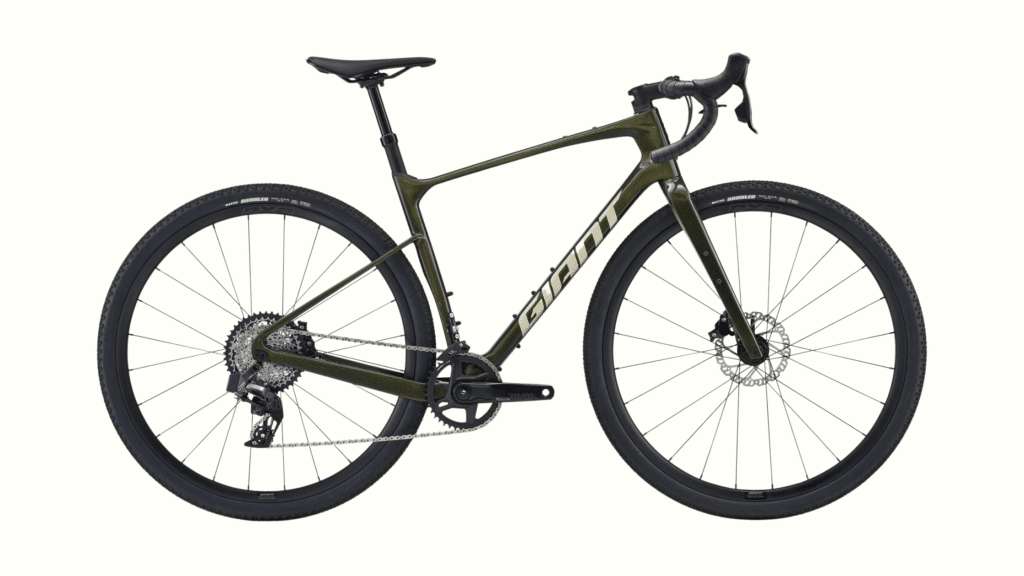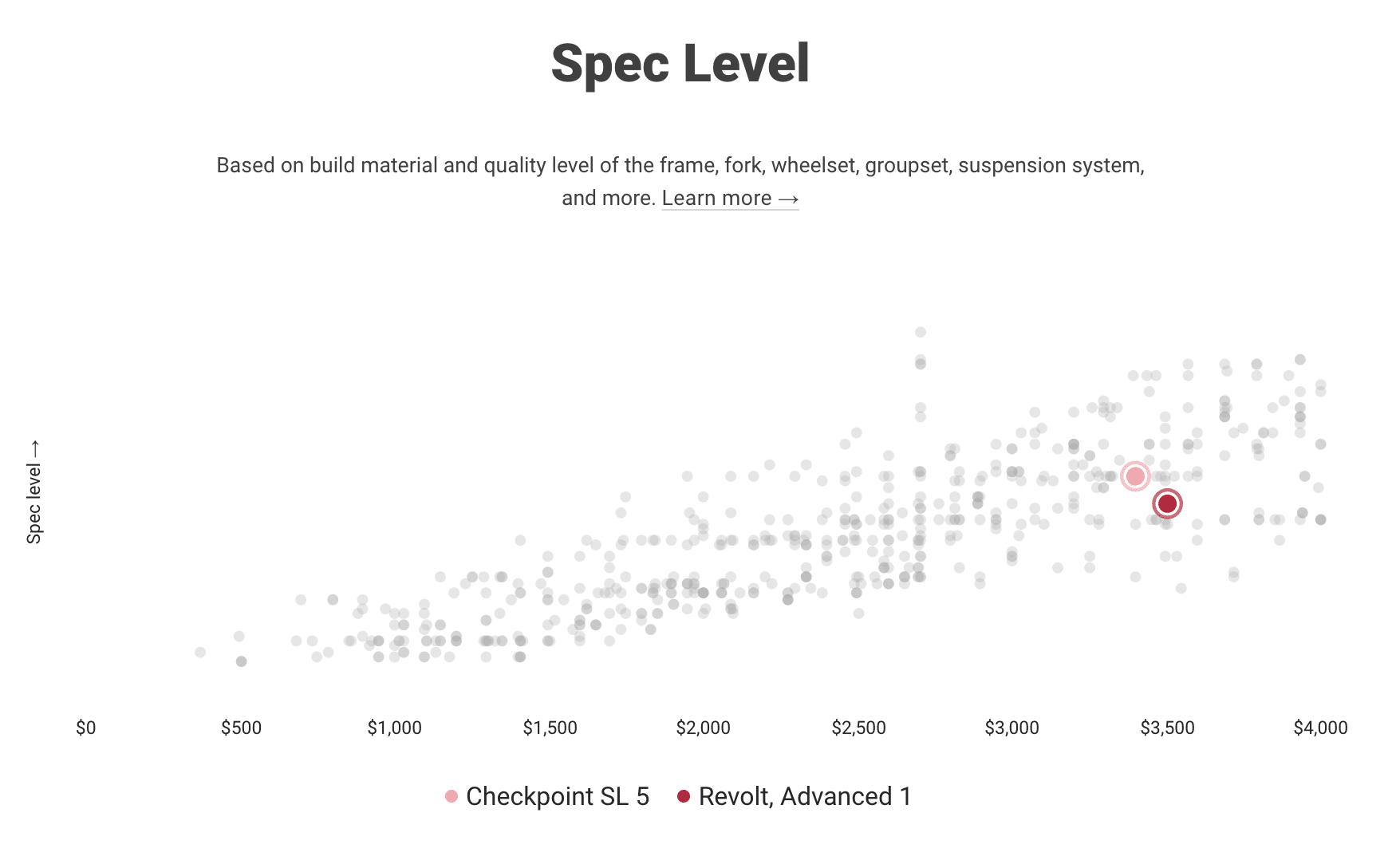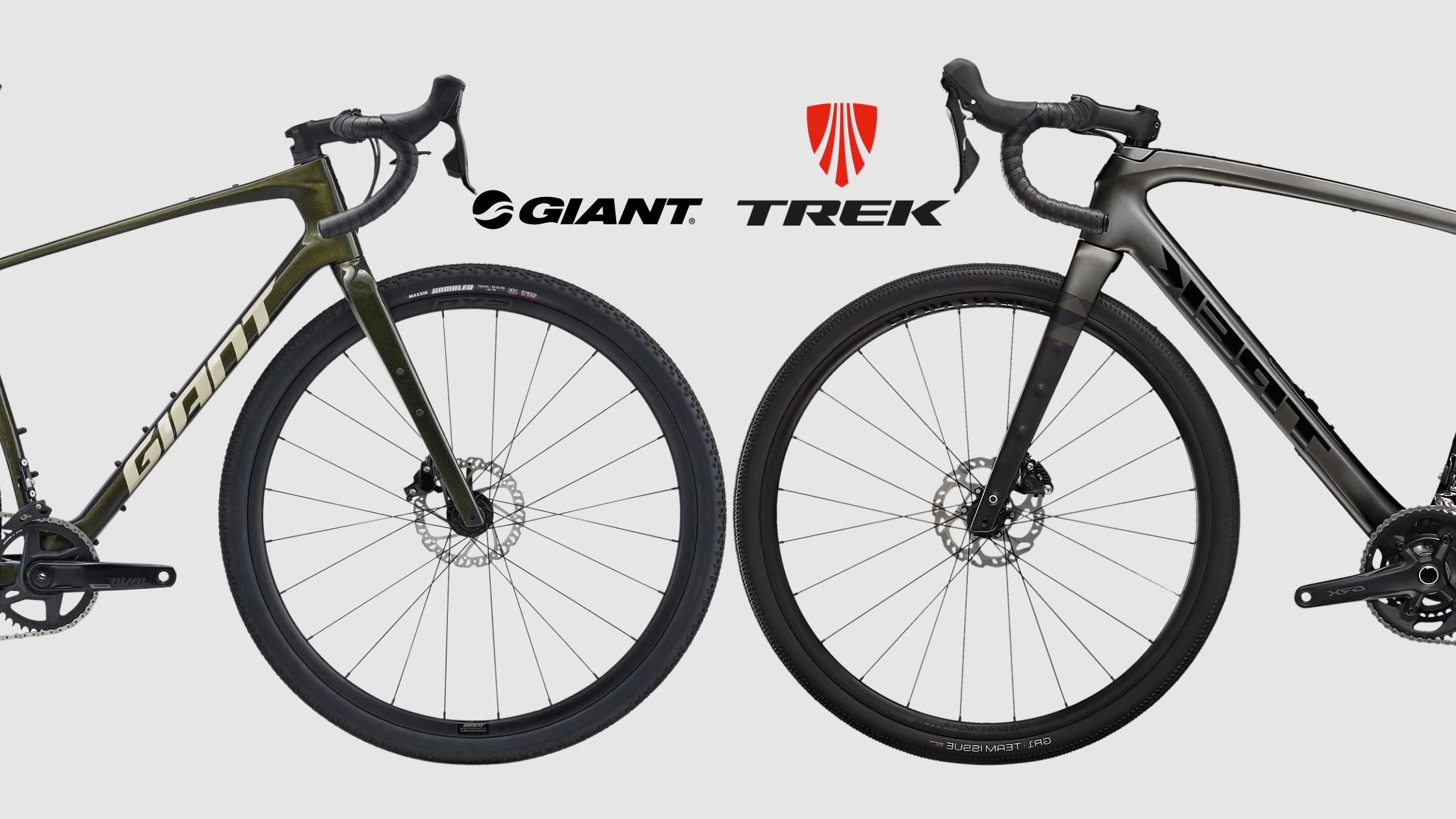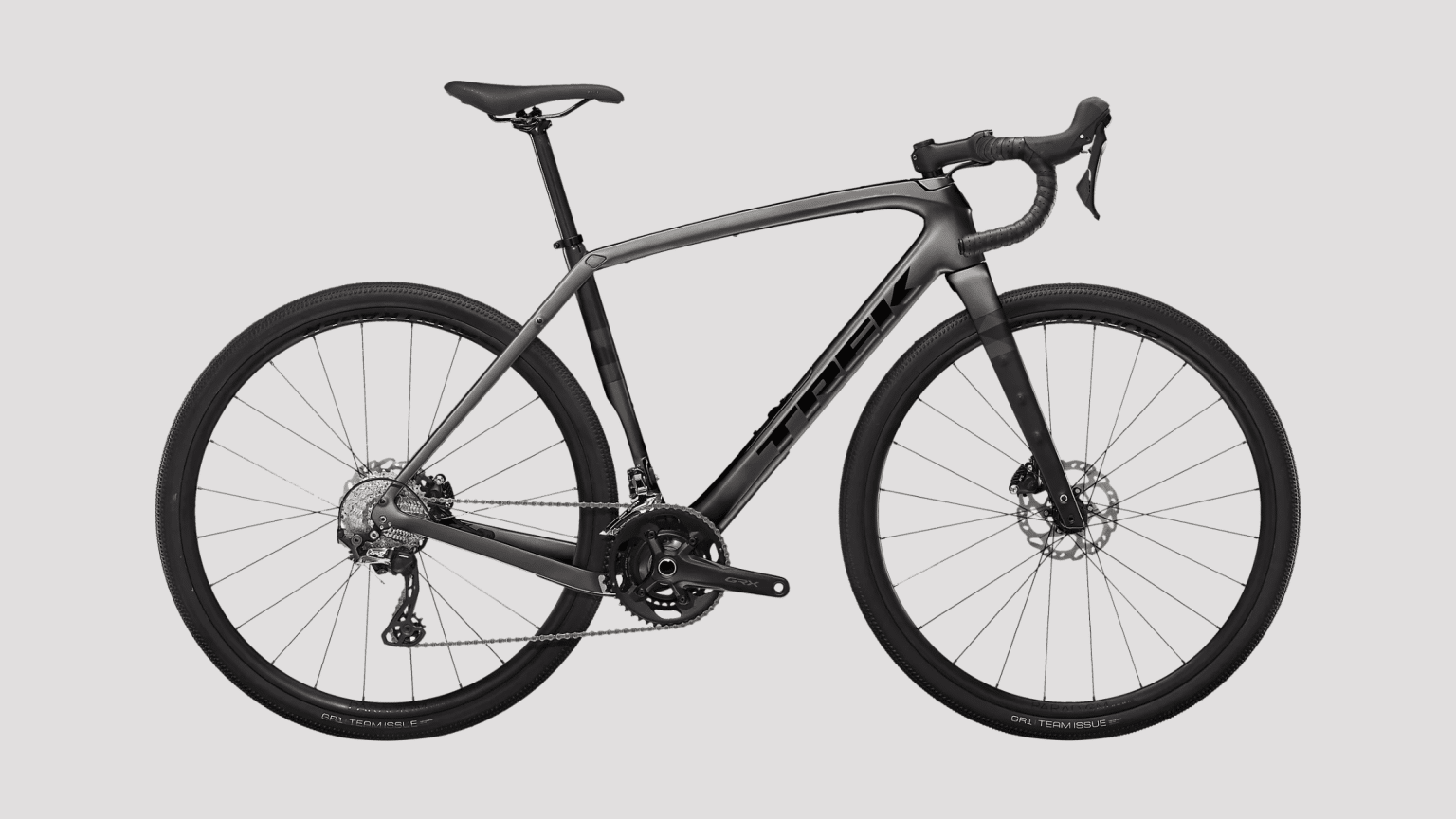The big brand gravel bike battle! Trek vs Giant! The big kids on the block who have been around forever. Which gravel bike is best? We are going to compare these two iconic gravel bikes side by side and see what the difference is between each.
Here at Cycle Travel Overload, we are all about adventure by bike. So this article will be focusing on the criteria of each bike that makes one hopefully better suited for adventures.
Introducing the Trek Checkpoint
The Trek Checkpoint seems to be one of the most popular gravel bikes on the market. So that means they are a great carbon gravel bike option, right?
The main feature of the Checkpoint is the lightweight OCLV Carbon frame with IsoSpeed, a decoupler at the top tube/seat tube junction that provides additional compliance over rough terrain so you can stay stronger for longer. A carbon gravel bike made for epic all-road adventures.
The Checkpoint is still fast, but more importantly comfortable and smooth, and its versatile design ensures that you’ll reach all the places you dream of exploring on two wheels.
But the same could be said for the Giant Revolt.
Introducing the Giant Revolt

The all-new 2023 model Giant Revolt is available in many different build options. Most exciting their hardtail bikes are the most interesting.
A decade ago, gravel riding was a relatively unknown category, and those who wanted to ride on mixed terrain had to modify cyclocross or road bikes.
Giant changed the game with the introduction of the Revolt in 2013. With its unique design, including a sloping top tube, dropped seatstays, disc brakes, and slim carbon seatpost, the Revolt revolutionized the gravel biking experience.
Giant’s pro gravel racers now rely on their Revolt race bikes, including the all-new Revolt Advanced Pro, Revolt Advanced, and Revolt.
These bikes offer lightweight efficiency, smooth compliance, and adaptability to make the most of any adventure.
The new Revolt models feature updated geometry for improved efficiency and performance, including a shorter wheelbase, reduced fork trail, longer reach, and steeper head angle.
The bottom bracket has also been lowered by 10mm. These are the lightest Revolt models ever, making them ideal for speed, agility, and a wide range of terrain.
Smooth compliance is achieved through a lower seatstay junction with thinner diameter tubes, as well as the latest D-Fuse seatpost and handlebar technology.
The seatpost reduces shocks and vibrations on rough roads, while the handlebar adds compliance at two key contact points.
A flip chip on the rear dropout lets riders adjust the wheelbase by 10mm, providing a quicker, more agile feel or greater stability on rougher roads. The frame has six water bottle mounts and adaptors for racks or fenders, and the option for a mountain bike-style dropper post.
Price – Revolt Vs Checkpoint
When it comes to price the Revolt has a plethora of options ranging from $2,650 to $8,500. While the Checkpoint ranges from $3,499 to $12,249. But what really is the difference and which one is best for you and your riding goals?
There are so many different models to choose from for each bike. For this article, we have taken their mid-range (best bang for buck option as a main comparison. Instead of comparing all models together.)
But when taking a look at these two, mid to high-end range models. There is a slight difference when it comes to price. The Trek Checkpoint SL 5 at $3,399.99 while the closest option in price that Giant offer is the Revolt Advanced 1 priced at $3,500

Taking a look at both bikes’ spec levels we can see that the Trek has the best bang for buck when it comes to offering the best quality components for the amount of money. The Trek Checkpoint is about $100 more affordable and you get GRX 800, GRX 600 compared to the Revolt’s SRAM Rival 1 setup. Both bikes come with Hydraulic disc brakes
Weight – Revolt Vs Checkpoint
The Specialized Diverge weighs 21 lbs and 5 oz / 9.67 kg, it was rather difficult to find the weight for this model of the Giant Revolt. All different build options and models weigh differently. Both bikes come close with the next model up for the Revolt weighing around 8.5 kg.
Tire Clearance – Revolt Vs Checkpoint
When it comes to tire clearance the Checkpoint fits 45mm x 700c or 2.1″ (which is approx 53 mm) x 650b wheels. While the Revolt fits up to 53mm wide. Both bikes show similarities here.
The Revolt comes stock with Maxxis Rambler, 700x45c tires. While the Trek comes with Bontrager GR1 Team Issue 700c x 40 mm tires.
Gearing – Revolt Vs Checkpoint
For the price, the Checkpoint offers a 2x setup while the Revolt comes in a 1x drivetrain which has a big impact on gearing. Which really affects the outcome of the bike’s performance in this specific comparison.
However, their prestige model the Giant Revolt X, Advanced Pro 0 comes with front suspension and a 1×12 setup with a much larger range of gearing.

As you can clearly see from the graph above the Trek Checkpoint is so much more superior when it comes to climbing and descending. When comparing the top two bikes which is the similar spec level Revolt. But that top-of-the-line Giant Revolt X, Advanced Pro 0 is made for steep climbing, and with suspension, it might just be the best adventure bike overall that both brands offer.
The Trek Checkpoint has 24.32″ climbing gear while the Giant Revolt has 26.63″. Both bikes aren’t ideal if you are looking for climbing gear best suited for bikepacking. As you ideally want something that is around 18″ to 20″. However, the Checkpoint is okay. Especially if you plan to ride fast and flat bike adventures.
Then we have the largest gear which is measured for riding fast downhill or on the flats. The gear inches for the Checkpoint is 115.53″ vs the Revolt 102.03″. As you again can see the Checkpoint is so much more superior for the largest gear applications.
The higher-end Revolt is again superior when it comes to gearing to the Checkpoint models. With the Giant Revolt X, Advanced Pro 0 comes with a 21.89″ climbing gear and 113.70″ largest gear.
If you want a bike with better climbing gear this might be your best bet. But it is very expensive in comparison.
Geometry – Revolt Vs Checkpoint
Geometry can play a big part in the difference between how a bike rides and feels. It is definitely something to consider when buying a bike. Okay, the moment I have been waiting for! So far these bikes have been rather similar in many ways. Here is where if there are any differences we can figure out which bike is better suited for you. All the measurements below are in mm and are for both medium-sized bikes.
Want to learn more about understanding bike geometry? Read this article which goes through all the jargon and what it means for a comfortable ride!
The main geometry specs that can paint the picture of the type of bike we are looking at are; stack/reach ratio, trail, chainstay, and wheelbase.
One my first impression I came to the conclusion that the Revolt was much better suited for fast and speedy bike races and adventures.
But taking a look at the details of the bike’s geometries the stack/reach ratio for the Checkpoint is 1.45 vs the Revolt 1.54, which suggests that the Revolt is a more upright bike and the Checkpoint is slightly more aggressive.
Meaning that the Revolt would be in theory a more comfortable bike to ride on bikepacking trips and for longer amounts of time in the saddle. While the Checkpoint would be better for performance-based riding where comfort isn’t as important and riding fast is the main priority. (Although this number is much more aggressive on some of the fastest gravel bikes.)
Chainstay is 5 mm longer on the Checkpoint. With measurements of 435 mm puts the Checkpoints chainstay right in that mid-range for a gravel bike, Which is where most all-rounder gravel bikes sit. While the Revolt measures 430 mm this means it’s rather short making it feel quick in the rear. Compared to a more balanced feel of the Checkpoint.
Specifically, if you want to run panniers the Checkpoint is your best bet this longer chainstay offers a more comfortable clearance from your feet and legs when pedaling.
But that longer chainstay and I am assuming wheelbase also makes the Checkpoint a more stable and planted bike especially when bikepacking or bicycle touring. The more stable the bike under a load the better. Also as expected the Checkpoint has a 13 mm longer wheelbase.
Now we’ll look at the trail. This tells the story of how each bike will corner and what the handling is like upfront.
The Revolt has around a 2 mm longer trail length at 67 mm which is in the higher end for gravel bikes making it feel rather stable upfront but not quite sluggish. While the Checkpoint falls in a similar category at 65 mm.
It really is a hard one, as both bikes seem like great candidates for adventure with the Revolt’s much more comfortable and upright riding position. But the Checkpoint seems more planted overall for carrying gear. Meaning the Checkpoint may feel more natural at carrying gear but it lacks upright comfort. And because here at Cycle Travel Overload that’s all we are about.
I would suggest either bike depending on what’s most important to you! Do you want to sacrifice a little bike handling and natural bike feel with gear for extra comfort when spending long days in the saddle? A bike that might feel fast.
The Revolt may be better suited to faster bikepacking than the Checkpoint is but you get slightly better comfortability with the Revolt.
| Bike | Revolt | Checkpoint |
| Stack | 602 | 592 |
| Reach | 391 | 407 |
| Stack/Reach Ratio | 1.54 | 1.45 |
| Top Tube Length | – | 584 |
| Seat Tube Length | 590 | 560 |
| Seat Tube Angle | 73 | 72.8 |
| Head Tube Length | 165 | 145 |
| Head Tube Angle | 72 | 72.2 |
| BB Drop | 80 | 76 |
| Front Center | 618 | 624 |
| Chainstay Length | 430 | 435 |
| Wheelbase | 1035 | 1048 |
| Rake | 50 | 45 |
| Trail | 65 | 67 |
| Standover Height | 769 | 809 |
It’s definitely much harder to pix one bike out of the two. As both boast some ideal qualities when it comes to adventure cycling. The Revolt offers more upright and comfortable riding positioning. While the Checkpoint’s chainstay and wheelbase are longer which is better suited for adventure cycling, especially with gear on the rear.
But the gearing in the Trek Checkpoint is hard to pass up (especially for these models) as you ideally want the lowest possible gear when adventure cycling.
In conclusion, I would say if you are looking for a fast bikepacking / gravel bike the Trek Checkpoint would be your go-to, but then again the Revolt can still be fast. However, that gearing gives the Checkpoint a slight edge.
But when it comes to adventure this is where it becomes more complicated and it is up to you to consider what characteristics you require the most, as both bikes compete quite evenly against each other when it comes to this type of implication.
But again as I always say and especially for these two bikes. Each bike has its own specialty that they bring to the table and the same rings true with the Revolt and Checkpoint. But I hope this article cleared up some things for you.


